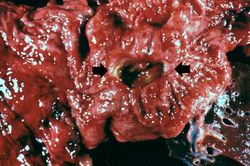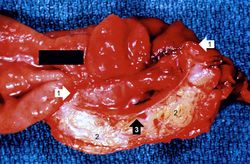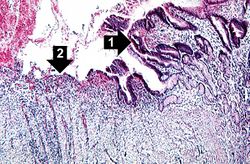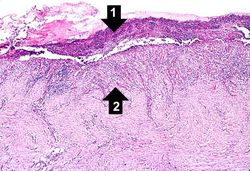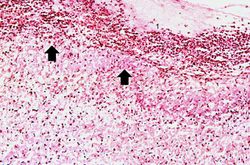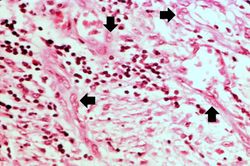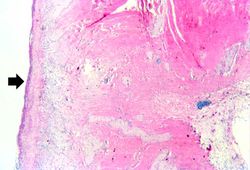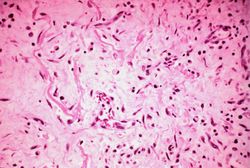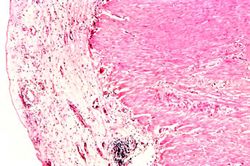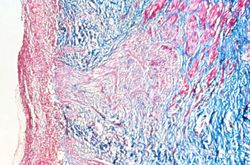Difference between revisions of "IPLab:Lab 3:Chronic Peptic Ulcer"
Seung Park (talk | contribs) |
Seung Park (talk | contribs) (→Reference) |
||
| Line 24: | Line 24: | ||
== Additional Resources == | == Additional Resources == | ||
=== Reference === | === Reference === | ||
| − | + | * [http://emedicine.medscape.com/article/181753-overview eMedicine Medical Library: Peptic Ulcer Disease] | |
| + | * [http://www.merckmanuals.com/professional/gastrointestinal_disorders/gastritis_and_peptic_ulcer_disease/gastritis.html Merck Manual: Gastritis and Peptic Ulcer Disease] | ||
=== Journal Articles === | === Journal Articles === | ||
Revision as of 22:19, 21 August 2013
Contents
Clinical Summary[edit]
This 56-year-old white female was admitted to the hospital with a six-year history of epigastric pain and burning. This pain was said to be worse at night and on an empty stomach. The patient reported that the pain was relieved by drinking milk. She had also experienced several episodes of hematemesis and melena since the onset of the pain, the last episode occurring 3 weeks prior to admission. The patient described intermittent episodes of colicky pain in the right upper quadrant and right side of the abdomen, frequently radiating to the back and shoulders and often accompanied by "bilious vomiting." Physical examination was noncontributory except for tenderness in the epigastrium and right upper quadrant. An upper GI series showed changes suggestive of a neoplasm. The patient submitted to an abdominal exploration at which time a partial gastrectomy was performed.
Images[edit]
This low-power photomicrograph demonstrates the healing reaction in the base of this ulcer. The base of the ulcer is at the left-hand side of the image and the serosal surface is at the right. Note the fibrous connective tissue within the wall of the stomach and the layer of inflammatory exudate on the surface of the ulcer (arrow).
Study Questions[edit]
Additional Resources[edit]
Reference[edit]
Journal Articles[edit]
Images[edit]
Related IPLab Cases[edit]
Hematemesis is the vomiting of blood.
Melena is the passage of digested blood in the feces.
Colicky pain is an intermittent abdominal pain.
Bilious vomitus is vomitus which contains bile.
An upper GI series is a series of barium-aided radiographs involving the esophagus, stomach, and duodenum.
Cirrhosis is a liver disease characterized by necrosis, fibrosis, loss of normal liver architecture, and hyperplastic nodules.
Hypercalcemia is the state of having increased levels of calcium in the blood.
The normal fibrinogen level is 184 to 412 mg/dL.
